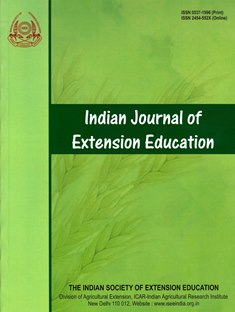Adoption of Climate-Smart Agriculture (CSA) in Flood-Affected Regions of Darbhanga
DOI:
https://doi.org/10.48165/IJEE.2025.61312Keywords:
CSA adoption, Flood-prone, Climate-smart practices, Regression, BiharAbstract
The study aimed to evaluate the extent of adoption of Climate Smart Agriculture (CSA) practices among farmers residing in flood-prone areas of Darbhanga, Bihar, and to identify the key socio-economic factors influencing adoption. Data were collected during 2024– 2025 from 160 respondents randomly selected from sixteen villages across four flood affected blocks. A pre-tested interview schedule encompassing five CSA components was employed to gather information on adoption levels and socio-economic characteristics. The adoption of CSA practices was predominantly partial and practice-specific. Crop production practices recorded mean adoption rate of 49.51 per cent, whereas smart water management at 38.37 per cent. Overall, 64.16 per cent of the respondents exhibited a moderate adoption level. Correlation analysis demonstrated significant positive associations between adoption and variables such as knowledge, income, education, and family size. Further, the regression model (R² = 0.500; F = 13.451; p < 0.01) identified knowledge, income, education, family size, and extension contact as significant predictors of CSA adoption. The study concluded that improving farmers’ knowledge and enhancing their economic capacity could substantially increase CSA adoption, thereby strengthening climate resilience. These results underscore the importance of targeted extension services and capacity-building programs tailored to vulnerable regions.
Downloads
References
Albore, A. (2018). Review on role and challenges of agricultural extension service on farm productivity in Ethiopia. International Journal of Agricultural Education and Extension, 4(1), 93-100.
Alzahrani, K., Ali, M., Azeem, M. I., & Alotaibi, B. A. (2023). Efficacy of public extension and advisory services for sustainable rice production. Agriculture, 13, 1062. https://doi.org/10.3390/agriculture13051062
Anderson, J. R., & Feder, G. (2007). Agricultural extension. Handbook of Agricultural Economics, 3, 2343-2378. https://doi.org/10.1016/S1574-0072(06)03044-1
Bahua, M. I., Jahi, A., Asngari, P. S., Saleh, A., & Purnaba, I. G. P. (2013). Factors affecting the performance agricultural extension and their impact at behavior maize farmers in Gorontalo Province. The Journal of Agricultural Education and Extension, 1, 1-10.
Bhavani, R. V. (2023). The National Commission on Farmers, 17 years on. Review of Agrarian Studies, 13(2), 80-86. https://doi.org/10.25003/RAS.13.02.0008
Chand, R., Saxena, R., & Rana, S. (2015). Estimates and analysis of farm income in India, 1983–84 to 2011–12. Economic and Political Weekly, 139-145. http://www.jstor.org/stable/24482496
Davis, K., Bohn, A., Franzel, S., Blum, M., Rieckmann, U., Raj, S., Hussein, K., & Ernst, N. (2018). What works in rural advisory services? Global good practice notes. Lausanne: Global Forum for Rural Advisory Services. http://www.betterextension.org
Deaton, A. (1997). The analysis of household surveys: A micro econometric approach to development policy. The World Bank.
Filmer, D., & Pritchett, L. (2001). Estimating wealth effects without expenditure data—or tears: An application to educational enrolments in states of India. Demography, 38(1), 115-132. https://doi.org/10.1353/dem.2001.0003
Jaiswal, M., Singh, A., Singh, B., & Singh, K. (2018). Assessment the usefulness, applicability & impact of Kisan Mobile Advisory Services (KMAS) by the farmers in Burhanpur district of Madhya Pradesh. Indian Journal of Extension Education, 54(3), 31-36. https://epubs.icar.org.in/index.php/IJEE/article/view/143882
Kumar, Y., Fatima, K., Raghuvanshi, M. S., Nain, M. S., & Sofi, M. (2022). Impact of Meghdoot mobile App - A weather-based agro advisory service in cold arid Ladakh. Indian Journal of Extension Education, 58(3), 142-146. http://doi.org/10.48165/IJEE.2022.58329
Nagar, A., Nauriyal, D. K., & Singh, S. (2021). Determinants of farmers’ access to extension services and adoption of technical inputs: Evidence from India. Universal Journal of Agricultural Research, 9(4), 127-137. https://doi.org/10.13189/ujar.2021.090404
NITI Aayog. (2022). Aspirational Districts Programme: An appraisal. Government of India. https://www.niti.gov.in/sites/default/files/2023-03/Aspirational-Districts-Programme-An-Appraisal.pdf
Priscilla, L., Kar, P., Krishnadas, O., Nivetina, L., & Sharma, P. R. (2021). Economic impact of crop diversification in North-East India: Evidence from household-level survey. Indian Journal of Extension Education, 57(4), 104-109. https://epubs.icar.org.in/index.php/IJEE/article/view/115529
Sentibenla, P., & Jha, K. K. (2024). Information sources utilization and adoption behaviour of pineapple growers in Nagaland. Indian Journal of Extension Education, 60(1), 46-52. https://doi.org/10.48165/IJEE.2024.60109
Singh, M., Burman, R. R., Sangeetha, V., & Iquebal, M. A. (2015). Constraints faced in mobile based agro-advisory services and strategy for enhancing the effectiveness of mKRISHI®. Indian Research Journal of Extension Education, 15(2), 119-122. http://www.seea.org.in/vol15-2-2015/24.pdf
Singh, S. S., Saikia, A. R., Saurabh, Leihaothabam, N. S., & Hemam, R. (2023). Insights into agricultural extension. Empyreal Publishing House.
Tayang, W., & Devi, M. N. (2024). Quantitative insights into extension advisory services: Enhancing rural livelihoods through evidence based analysis. Journal of Experimental Agriculture International. https://doi.org/10.9734/jeai/2024/v46i113080
Venu, L., Singh, B., Kumar, P., & Vijayaragavan, K. (2013). Agricultural extension in India – the effectiveness of the Agricultural Technology Management Agency. Outlook on Agriculture, 42(1), 65-71. https://doi.org/10.5367/oa.2013.0115
World Bank. (2021). Transforming agriculture in India: Vision 2030. https://www.worldbank.org/en/programs/sdgs-2030-agenda
Wossen, T., Abdoulaye, T., Alene, A., Haile, M. G., Feleke, S., Olanrewaju, A., & Manyong, V. (2017). Impacts of extension access and cooperative membership on technology adoption and household welfare. Journal of Rural Studies, 54, 223-233. https://doi.org/10.1016/j.jrurstud.2017.06.022
Yaseen, M., Ahmad, M. M., Soni, P., Kuwornu, J. K. M., & Saqib, S. E. (2021). Factors influencing farmers’ utilisation of marketing information sources: Some empirical evidence from Pakistan. Development in Practice. https://doi.org/10.1080/09614524.2021.1911941
Downloads
Published
Issue
Section
License

This work is licensed under a Creative Commons Attribution-NonCommercial-NoDerivatives 4.0 International License.

